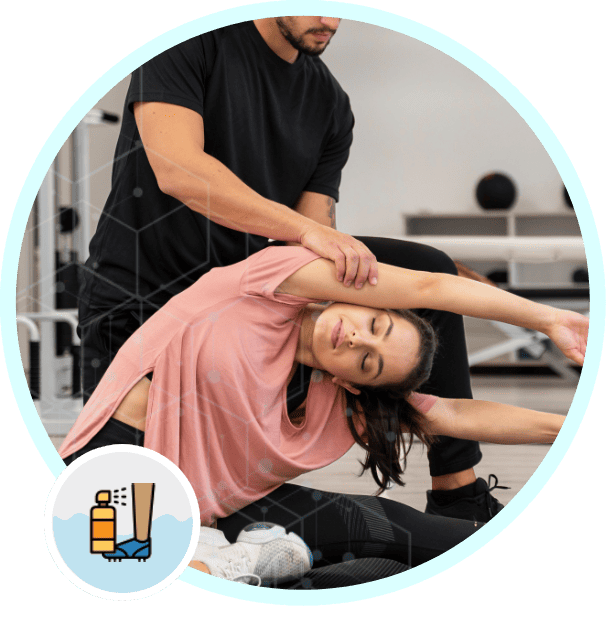
At OSS, we have expertise in the non-operative management of musculoskeletal pain and sports injuries. Surgery will be offered to treat your injury only if considered necessary. Our experts will evaluate your injury, consider necessary investigation, and prescribe the necessary treatment to help you recover from your injuries. We aim to keep you active regardless of your age or level of activity, so that you can enjoy what you love to do.
Common sport injuries we treat
- Joint pain
- Musculoskeletal pain – pain in the bone or muscle or tendon or ligament (sprain or strain)
- Ligament tear such as MCL tear or labral tear
- Tendon tear such as rotator cuff or biceps or triceps or pectoralis major tendon tear
- Tendinitis or tendinopathy
- Exercise induced pain
- Joint dislocations
Facilities
Rehabilitation & Training
At our clinic, the majority of sports related injuries are treated successfully with exercises, enabling a full return to previous levels of activity. After thorough evaluation of your condition, the consultant will offer you exercises to improve your pain. Our consultants will also recommend pre-operative rehabilitation (Prehab) to prepare you physically for surgery when you need.
Ultrasound Guided Injections
To reduce pain and inflammation, our consultants will consider injections into your joint or around the tendons. Common injections given at our clinic are steroid, hyaluronidase, platelet-rich-plasma (PRP) and bone marrow aspirate concentrate (BMAC). Our specialists have the expertise in giving ultrasound-guided injections with greater accuracy and better patient outcome.
Sports surgery
It is a subspecialty of orthopaedic surgery that focuses on the treatment of injuries related to sports and physical activity. These surgeries aim to restore function, reduce pain, and return athletes—both professional and recreational—to their prior level of performance.
Sports surgeons often treat acute injuries (like ligament tears) and chronic conditions (like tendonitis or impingement syndromes) that fail to improve with non-surgical treatment.
Surgical Techniques
- Arthroscopy (minimally invasive)
- Small incisions, faster recovery, less scarring.
- Open Surgery
- Necessary for more complex reconstructions.
- Longer healing time, but may provide better access for certain repairs.
Common Upper Limb Sports Surgeries treated at OSS are
The Surgical Experience
Pre-Operative
- Comprehensive assessment includes physical exam, imaging (MRI, X-ray), and functional testing.
- Athletes are often guided through prehabilitation to strengthen the area before surgery.
Anaesthesia
- General anaesthesia or regional blocks are commonly used, depending on the procedure.
Hospital Stay
- Most sports surgeries are outpatient procedures.
- Patients typically go home the same day with a brace, sling
Recovery and Rehabilitation
- Initial Recovery (0–2 weeks): Pain control, swelling reduction, immobilization.
- Early Rehab (2–6 weeks): Gradual passive and active motion.
- Strengthening Phase (6–16 weeks): Functional strengthening and neuromuscular control.
- Return-to-Sport (4–12 months): Sport-specific drills, performance testing.
Physical Therapy
- A cornerstone of successful recovery.
- Customized programs based on sport, position, and goals.
- May include balance training, endurance, plyometrics, and proprioception.
Outcomes and Return to Play
- Return-to-Sport Rates vary by injury, sport, and level of play.
- Many athletes regain pre-injury levels.
- Some sports show decline in explosiveness or durability depending on the surgery.
Risks and Complications
- Infection
- Blood clots (DVT)
- Stiffness or loss of motion
- Graft failure or re-tear
- Nerve injury (rare)
Psychological Aspects
- Athletes may face fear of re-injury, anxiety about performance, and identity loss.
- Mental readiness is a crucial factor in successful return to sport.
- Many teams incorporate sports psychologists into the rehab process.
Sports surgery is an essential tool in modern athletics, offering athletes a path back to performance after injury. While not all injuries require surgery, when conservative treatment fails, surgical intervention can restore function and extend careers.
Key factors in successful outcomes include:
- Timely and accurate diagnosis,
- Skilled surgical technique,
- Personalized and consistent rehabilitation,
- Strong mental resilience.
Sports surgery is not a shortcut—it’s a strategic reset that, when done properly, can lead to full recovery and even enhanced performance.




